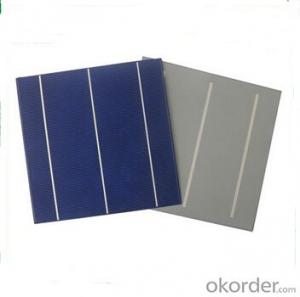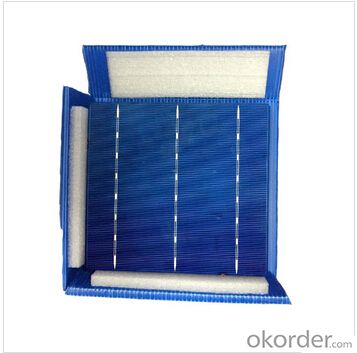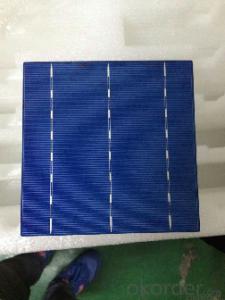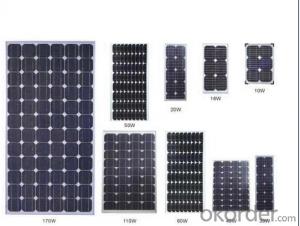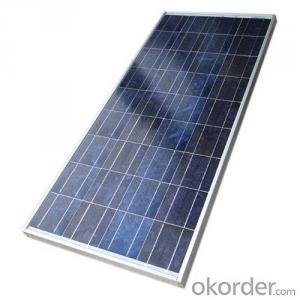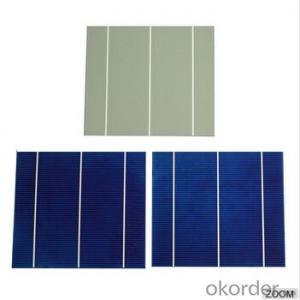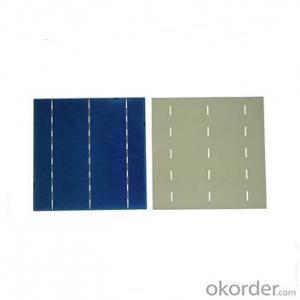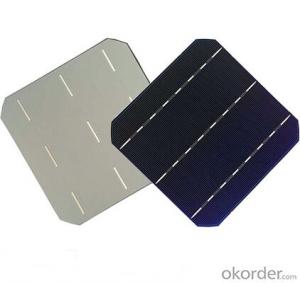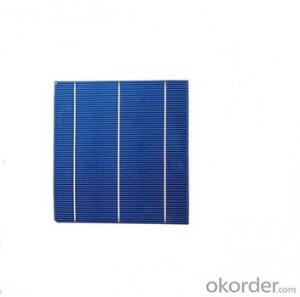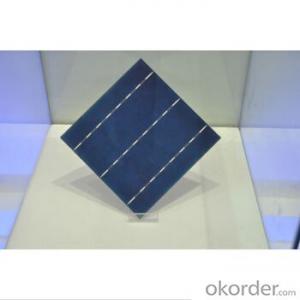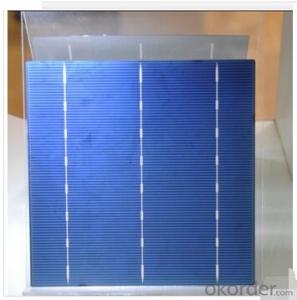Aiko Solar Cells - Polycrystalline Solar Cell High Quality 16.00%-16.25% Effy
- Loading Port:
- Shanghai
- Payment Terms:
- TT OR LC
- Min Order Qty:
- 1000 pc
- Supply Capability:
- 1000000 pc/month
OKorder Service Pledge
OKorder Financial Service
You Might Also Like
Solar Cells:
Solar cells is made by solar wafer, it has three categories of solar cell right now, monocrystalline polycrystalline and thin film,These cells are entirely based around the concept of PN junction, which is the critical part of solar module, it is the part that can convert the light energy into electricity, the thickness is from 180um to 200um, with even busbars to conduct electricity, textured cell can decrease diffuse reflection; they are often electrically connected and encapsulated as a module. Photovoltaic modules often have a sheet of glass on the front (sun up) side, allowing light to pass while protecting semiconductor wafers from abrasion and impact due to wind-driven debris, rain, hail, etc. Solar cells are also usually connected in series in modules, creating an additive voltage. Connecting cells in parallel will yield a higher current;With high quality and stable quality. Our Cells can greatly improve the performance of Solar Modules.
Features:
High efficiencies up to 16.4%
Proven long term mechanical stability of silicone
Make of highly purified poly silicone
Three bus bars for reduced series resistance and improved module and cell efficiency
Blue anti-reflecting coating ensures improved light absorption and increased efficiency
Acid texturization offers a uniform appearance and virtually invisible crystal structure
Excellent low light behavior for improved energy yield
Specifications
Size | 156mm x156mm ±0.5mm | |||||
Thickness | 190um ± 20um | |||||
Front surface(-) | 1.7mm bus bars(silver), blue anti-reflecting coating(Silicon nitride) | |||||
Back surface (+) | 3mm wide soldering pads(silver) back surface field(Aluminum) | |||||
TkVoltage | -0.351%/K | |||||
TkCurrent | +0.035%/K | |||||
TkPower | -0.47%/K | |||||
Efficiency(%) | Pmp(W) | Vmp(V) | Imp(A) | Voc(V) | Isc(A) | FF(%) |
16.25-16.50 | 3.99 | 0.516 | 7.731 | 0.621 | 8.262 | 77.77 |
16.00-16.25 | 3.92 | 0.512 | 7.660 | 0.616 | 8.195 | 77.68 |
Solar Cells Advantage:
1. High efficiency and High power.
2. Long-term electrical stability.
3. Lowest price and Fastest delivery.
4. Good quality and good service.
5.Bulk supply
6. Good Warranty
7.Big Sale
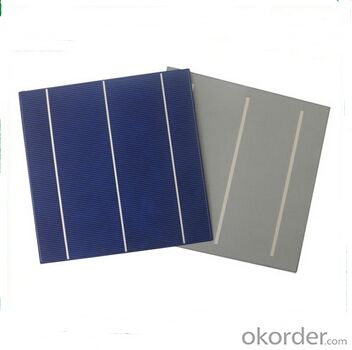
FAQ
We have organized several common questions for our clients,may help you sincerely:
①What price for each watt?
It depends on the efficiency of the solar cell, quantity, delivery date and payment terms.
②How long can we receive the product after purchase?
In the purchase of product within three working days, We will arrange the factory delivery as soon as possible. The pecific time of receiving is related to the state and position of customers.Commonly 7 to 10 working days can be served.
③Can you provide the peripheral products of the solar panels, such as the battery, controller, and inverter? If so, can you tell me how do they match each other?
Yes, we can, we have two companies for solar region, one is CNBM International, the other is CNBM engineering Co.
We can provide you not only the solar module but also the off grid solar system, we can also provide you service with on grid plant.
④What is your warranty of solar cell?
Our product can promise lower than 0.3% open box crack, we support claim after opening the box if it has crackm color difference or sth, the buyer should give pictures immediately, we can not accept the claim after the solar cell has assembled to solar panel.
• Timeliness of delivery
• ⑤How do you pack your products?
We have rich experience on how to pack the solar cell to make sure the safety on shipment, we could use wooden box or pallet as buyer's preference.
- Q: What is the impact of hailstorms on solar cells?
- Hailstorms can have a detrimental impact on solar cells. The physical impact of hailstones can cause cracks or shattering of the solar panels, leading to reduced efficiency or complete failure of the cells. Additionally, the protective layers of the solar panels can be damaged, making them more susceptible to moisture intrusion and corrosion. Overall, hailstorms pose a significant risk to the durability and performance of solar cells.
- Q: Can solar cells be used in portable devices?
- Yes, solar cells can be used in portable devices. They can be integrated into various portable devices such as smartphones, tablets, and portable chargers to harness sunlight and convert it into electrical energy, providing a sustainable and renewable power source for these devices.
- Q: How do solar cells perform in regions with high levels of humidity and rainfall?
- Solar cells generally perform well in regions with high levels of humidity and rainfall. While moisture in the air can reduce the efficiency of solar cells to some extent, modern solar panels are designed to withstand these conditions. Additionally, rain can actually help clean the panels, removing dust and dirt that may accumulate over time. Overall, solar cells can still generate a significant amount of electricity in regions with high humidity and rainfall.
- Q: Can solar cells be used to power remote wildlife monitoring systems?
- Yes, solar cells can be used to power remote wildlife monitoring systems. Solar cells convert sunlight into electricity, providing a reliable and renewable source of power for monitoring equipment in areas without access to the grid. This makes them an ideal solution for remote wildlife monitoring systems, allowing for continuous data collection and monitoring while minimizing the need for maintenance and manual power supply.
- Q: How do solar cells perform in areas with high levels of radiation?
- Solar cells perform well in areas with high levels of radiation. The excess radiation actually increases the energy output of the solar cells, allowing them to generate more electricity.
- Q: Can solar cells be used in desert environments?
- Yes, solar cells can be used in desert environments. In fact, desert environments are ideal for solar power generation due to abundant sunlight. The high solar irradiance levels in deserts provide excellent conditions for solar panels to generate electricity efficiently. Additionally, solar panels can withstand the extreme heat and sandstorms typically found in desert regions.
- Q: What is the impact of solar cells on reducing air pollution from power generation?
- Solar cells have a significant impact on reducing air pollution from power generation. By harnessing the sun's energy, solar cells produce clean electricity without emitting harmful pollutants like carbon dioxide and other greenhouse gases. This reduces the reliance on fossil fuels, which are major contributors to air pollution and climate change. Additionally, solar cells help to decrease the release of other harmful pollutants, such as sulfur dioxide and nitrogen oxides, which are commonly emitted during traditional power generation. Overall, the widespread adoption of solar cells can greatly contribute to improving air quality and mitigating the adverse effects of power generation on the environment.
- Q: Can solar cells be used for powering electric gates?
- Yes, solar cells can be used to power electric gates. Solar cells convert sunlight into electricity, which can be stored in batteries or directly used to power various devices. By installing solar panels near the gate, the generated electricity can be utilized to operate and control electric gates, providing a sustainable and reliable source of power.
- Q: Can solar cells be used in public transportation?
- Yes, solar cells can be used in public transportation. Solar panels can be installed on the roofs of buses, trains, and trams to generate electricity from sunlight. This renewable energy can be used to power various systems in public transportation, such as lighting, air conditioning, and even charging onboard devices. Additionally, solar cells can also be used to charge electric vehicles used in public transportation, reducing reliance on fossil fuels and contributing to a more sustainable transportation system.
- Q: How do monocrystalline solar cells differ from polycrystalline solar cells?
- Monocrystalline solar cells are made from a single crystal structure, which results in a uniform and continuous appearance. On the other hand, polycrystalline solar cells are made from multiple crystals, leading to a more fragmented and less uniform appearance. In terms of efficiency, monocrystalline solar cells tend to have higher efficiency rates due to their uniformity, while polycrystalline solar cells have slightly lower efficiency but are generally more cost-effective.
Send your message to us
Aiko Solar Cells - Polycrystalline Solar Cell High Quality 16.00%-16.25% Effy
- Loading Port:
- Shanghai
- Payment Terms:
- TT OR LC
- Min Order Qty:
- 1000 pc
- Supply Capability:
- 1000000 pc/month
OKorder Service Pledge
OKorder Financial Service
Similar products
Hot products
Hot Searches
Related keywords
